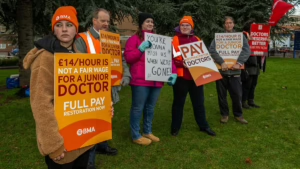Research by HR and payroll software provider Ciphr shows that most people significantly underestimate how pervasive the gender pay gap is in most occupations and industries in the UK.
Ciphr commissioned a survey of 2,000 UK adults, including 1,188 employees, to find out how closely people’s perceptions of the gender pay gap (if any) matched reality.
The findings revealed that a quarter (25%) of men and a fifth (19%) of women don’t think there are any job roles in the UK with gender pay gaps in favour of men in 2024. The latest figures from the Office for National Statistics (ONS), however, tend to prove otherwise.
According to the ONS, across all occupations, the median gender pay gap is 13.1%. This means that women working in the UK earn £2.39* less per hour, on average, than their male peers.
Based on Ciphr’s analysis of the data, nearly three-quarters (71%) of all jobs – even those predominately held by women – and the majority (89%) of industries in the UK, have gender pay gaps (of 1% or higher) in favour of men.
Yet, concerningly, just 1 in 10 employees say their industry has a gender pay gap in favour of men. And even fewer (8%) believe that their occupation or employer have gender pay gaps in favour of men.
This may be true for many employers but not as a rule. Especially not larger organisations. The UK government’s 2023-24 gender pay gap reporting data reveals that over three-quarters (78%) of organisations, with over 250 employees, pay their male employees more than their female employees (62% of these companies have a gender pay gap of 5% or more).
The results highlight that many employees have a skewed perception, or lack of knowledge, of the gender pay gap generally. Many also view their occupation’s, industry’s, or organisation’s gender pay gaps more positively than they perhaps should – which does nothing to help close any gaps that may exist.
That said, the workers most likely to be aware that their industry may have a gender pay gap problem include those employed in marketing, advertising and PR. Nearly two-fifths (38%) of people working in this sector, which is classified under professional, scientific and technical activities (by the ONS), think there’s a gender pay gap. And there is, at 20.1%, with women earning just 80p for every £1 men earn.
Around one in four survey respondents working in insurance and pensions, social care, and recruitment and HR also think their industries have gender pay gaps. They all do, at 29.8% (financial and insurance activities), 11.2% (human health and social work activities), and 6.2% (administrative and support service activities) respectively.
In comparison, those working in healthcare, retail, and teaching are among the least likely to say that their industry has a gender pay gap in favour of men. All these sectors do though – of 11.2% or more (the gender pay gap for education is 17.2%).
Here are the industries that surveyed employees thought most likely to have gender pay gaps in favour of men:
| Sector employee works in | Industry (ONS) | Share of employees who think their industry has a gender pay gap | Gender pay gap in 2024 |
| All surveyed employees | 10% | 13.1% | |
| Marketing, advertising and PR | Professional, scientific and technical activities | 38% | 20.1% |
| Insurance and pensions | Financial and insurance activities | 27% | 29.8% |
| Recruitment and HR | Administrative and support service activities | 25% | 6.2% |
| Social care | Human health and social work activities | 23% | 11.2% |
| Energy and utilities | Electricity, gas, steam and air conditioning supply | 20% | 14.5% |
And the industries employees thought least likely to have gender pay gaps in favour of men:
| Sector employee works in | Industry (ONS) | Share of employees who think their industry has a gender pay gap | Gender pay gap in 2024 |
| Charity and voluntary work | Human health and social work activities | 0% | 11.2% |
| Leisure, sport and tourism | Arts, entertainment and recreation | 0% | 6.4% |
| Public services and administration | Public administration and defence; compulsory social security | 3% | 8.8% |
| Healthcare | Human health and social work activities | 4.2% | 11.2% |
| Retail | Wholesale and retail trade; repair of motor vehicles and motorcycles | 4.8% | 12.7% |
(UK industries and their gender pay gaps, ONS 2024)
Employers ‘must do more’ to close the gap
Claire Williams, chief people and operations officer at Ciphr, says: “The findings of this survey highlight an urgent need for employers to take a more active role in promoting transparency and understanding around their gender pay gap. The data shows a significant disconnect between perception and reality, with many employees unaware of the extent of gender pay disparities in the UK. This lack of awareness reinforces the importance of clear communication and education within organisations.
“The UK’s stubbornly high, double-digit (13.1%) gender pay gap reflects systemic issues that cannot be ignored. It’s not just a matter of fairness – it’s a matter of equity, engagement, and trust in the workplace. Employers must do more to uncover and address the root causes of these disparities, from recruitment practices to career progression and pay structures.
“By fostering transparency and taking concrete, measurable actions, organisations can begin to close the gap and create a workplace that truly values and rewards talent equally, regardless of gender.”
Ann Allcock, head of diversity at Ciphr, adds: “Some of the overarching causes of the gender pay gap can include direct gender stereotyping and pay discrimination; occupational segregation – where there’s a gender imbalance in a role’s workforce, which can impact wages (such as more CEOs being men, or more PAs being women); women’s disproportionate unpaid caring responsibilities – where they may require more flexible working arrangements to support children or older relatives; and the ‘broken rung’ on the corporate ladder – where women may not have the same promotion opportunities to advance to management as men.
“Employers need to ensure that they fully understand what factors, if any, could be contributing to the gender pay gap within their own business, so they can make proactive changes. This includes conducting regular equal pay audits, promoting flexible working and parental leave options to all parents and carers, and reviewing policies and practices on starting salaries, performance-related pay, and bonus eligibility.
“Most importantly, have robust reporting capabilities in place via your HR system that can track your gender pay gap, take-up rates of flexible working, starting salaries by different genders, and return rates after maternity leave. It’s also worth considering how your recruitment and promotion practices may affect men and women differently. That can have a big impact on attracting and retaining the best employees.”
Jobs that pay men more than women
According to Ciphr’s latest gender pay gap study, some jobs have considerably wider gender pay gaps than 13.1% (the UK’s average for all full- and part-time jobs).
Female financial managers and directors, for example, only earn 72p, on average, for every pound men in those roles earn. This works out to £11.81 less an hour (thanks to its gender pay gap of 27.8%).
Other commonly held jobs with big gender pay gaps include electricians (20.7% gender pay gap), business sales execs (17.1%), programmers and software development professionals (15.8%), protective service associate professionals (15.3%, including coastguards, CCTV officers, crime scene examiners and immigration officers), retail managers (13.9%), marketing managers (13.6%), solicitors and lawyers (13.4%), office managers (13.4%), and CEOs (13.4%).
Just six occupations – including bar staff, retail cashiers and check-out operators, senior care workers, hairdressers and barbers, biological scientists, and national government administrative occupations (admin roles in the government and armed forces, at the ONS, HM Land Registry, courts of justice, Jobcentre Plus, Met Office, and Health and Safety Executive, for example) – have gender pay parity in 2024.
Ciphr’s gender pay gap study, including infographics showing which jobs, and parts of the UK, have the widest (and smallest) gender pay gaps for full-time workers, is available at https://www.ciphr.com/infographics/gender-pay-gap-statistics-2024.
Ciphr’s gender pay gap survey was conducted by OnePoll in November 2024. Over half (59% or 1,188) of the 2,000 respondents are currently employed. More survey results are available at: https://www.ciphr.com/infographics/gender-pay-gap-statistics-2024#survey.
Ciphr is the go-to HR software and solutions partner for medium and large organisations in the UK. Its integrated HR, payroll, benefits, learning and recruitment software, services and content provide invaluable insights to HR teams to inform their people strategy and grow and develop their organisations. Based in Reading, Ciphr is on a mission to amplify the voice and value of HR through intelligent people data solutions that help HR be heard – in the boardroom and across the business.
For more information, please visit www.ciphr.com.
The post Most people underestimate the scale of the UK’s gender pay gap first appeared on HR News.



